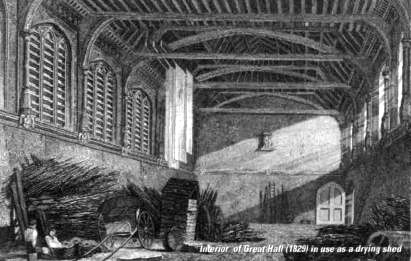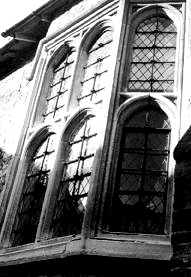
Addiscombe
Home
Heritage
Feedback
Croydons Old Palace

Manor house, palace, prison to a king, seat of industry, girls' school Croydon's Old Palace has filled many roles in its 1,000 years.
Nowadays filled with girls learning the Three R's and a fair bit more besides. The history of the buildings that sit adjacent to the Parish Church is filled with all forms of life, from the medieval grandeur of the archbishops of Canterbury to the drudgery of a 19th century washhouse.
A minster stood on the site in Anglo Saxon times and King Ethelbert of Kent whose wife Bertha was a Christian, gave it to the archbishops of Canterbury following his own conversion to Christianity.

The main residence of the archbishops was not surprisingly in Canterbury, but they had other castles, seats and manors in which they resided as their work took them around the country. One of those was the manor of Croydon.
Entries in The Domesday Book show that when William the Conqueror's commissioners visited Croydon the manor was occupied by Archbishop Lanfranc appointed to the post by William. Originally from Pavia in Italy he is regarded as the founder of the Croydon Palace and was Archbishop of Canterbury from 1070 to 1089.
The oldest parts of the existing building are more recent than Lanfranc's time but the foundations date from before the 11th century. Records kept at Lambeth Palace date from the time of Archbishop Peckham in 1279, leaving two centuries unaccounted for. It is possible the missing records are in The Vatican because Peckham's predecessor, Archbishop Kilwardby, had been given the Cardinal Bishopric of Porto and Santa Rufina. He resigned the seet of Canterbury and went to Italy, where he died a year later.

The next 200 years saw many alterations and repairs carried out to Croydon's Palace. Although not entirely rebuilt, it had originally been of timber construction, the wood probably coming from the forests which at that time covered Surrey, changed completely since its creation.
At the beginning of the 15th century, Prince James, while a prisoner in England for some 18 years - and later to become King James I of Scotland - was confined at the Palace for a time in the custody of Archbishop Arundell.
The archbishop who is today probably most readily linked to Croydon was John Whitgift and he is thought to have spent a small fortune in the upkeep of the Palace for the entertaining of Queen Elizabeth I who was a frequent visitor. In 1567 she held a council there, and in 1573, with all her attendants, enjoyed the Archbishop's hospitality for a week.
The 200 years following Elizabeth's death saw the Palace lose its former importance. By 1748 its condition had deteriorated to such an extent that it was necessary for Archbishop Herring to spend a large sum in restoring it, though the restoration work was out of harmony with the rest of the building.

A decade later the Palace ceased to be the residence of Their Graces and gradually fell into decay until an Act of Parliament enabled its sale and the purchase of not too distant Addington Palace.
Initial plans had been to replace Croydon Palace with a new residence on Park Hill. Change was rapid during the 19th century with much of the Palace being demolished and the Croydon, Merstham and Godstone Railway being laid through the part of the grounds which now comprise Church Road. It was around this time that parts of the buildings became dwellings.
The 1841 census shows that there were 15 households registered as living in the Palace, while industry moved into other parts. Among recommended uses mentioned in an 1829 sales catalogue were paper making, warehousing, calico-printing, silk mills or "other manufactories requiring extensive machinery".
The formation in 1850 of the Local Board of Health resulted in the filling in or culverting of the ponds and streams that covered the grounds. They had become polluted and were the cause of several local epidemics.
At various times floors had been installed in the Palace's Great Hall and it had been divided into many small rooms, while other parts of the buildings and gardens had been given over to the washing and bleaching of linen.

In yet another disparate twist a home for Anglo Indian children occupied part of the Palace during the 1870's.
Since the early part of the 19th century the Starey family had owned various parts of the Palace and its grounds but by 1886 the then owner Ann Starey decided she wanted to sell up. Plans to buy the building and convert it to Croydon Free Library were abandoned when the money could not be raised.
The Vicar of Croydon was also interested but he too could not meet the asking price. It fell to the Duke of Newcastle to step in and buy the Palace in 1887 and he handed it over to the Sisters of Mercy of the Church of England.
The intent was to open a girls' school but, before that could happen it urgently needed repairs, as well as raising the necessary funds the Sisters took on a lot of the manual work involved. The school opened in 1889 and remained in the care of the Sisters of Mercy until 1975, when it was adopted by the Whitgift Foundation.
It is thanks to the work and care bestowed on the building by the Sisters that Croydon can enjoy this unique and historic building.
Old Palace, as it is known today is open to the public several times a year when tours of the ancient building are conducted.
For more information about both the Old Palace and its guided tours, visit www.friendsofoldpalace.org.